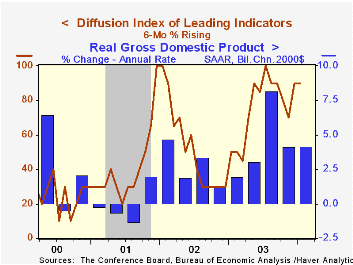 Global| May 20 2004
Global| May 20 2004Initial Jobless Insurance Claims Up
by:Tom Moeller
|in:Economy in Brief
Summary
Initial claims for jobless insurance rose 12,000 last week to 345,000 and the prior week's increase was revised up slightly. Consensus expectations had been for a decline in claims to 325,000. The latest figure covers the survey [...]

Initial claims for jobless insurance rose 12,000 last week to 345,000 and the prior week's increase was revised up slightly. Consensus expectations had been for a decline in claims to 325,000.
The latest figure covers the survey period for May nonfarm payrolls and initial claims were down 11,000 (3.1%) from the April period.
The 4-week moving average of initial claims fell to 333,500 (-21.7% y/y).
Continuing claims for unemployment insurance fell 23,000 following a downwardly revised gain of 51,000 the week prior.
The insured rate of unemployment dropped back to 2.3%, the three year low.
| Unemployment Insurance (000s) | 5/15/04 | 5/08/04 | Y/Y | 2003 | 2002 | 2001 |
|---|---|---|---|---|---|---|
| Initial Claims | 345 | 333 | -18.6% | 403 | 404 | 406 |
| Continuing Claims | -- | 2,943 | -19.4% | 3,533 | 3,573 | 3,023 |
by Tom Moeller May 20, 2004

The Composite Index of Leading Economic Indicators reported by the Conference Board rose a slightly less-than-expected 0.1% in April, but the prior month's gain was revised to 0.8% from 0.3% reported initially.
The slackening in April reflected m/m gains in only 40% of the component series versus gains in 70% of the components over a six-month span. During the last ten years there has been a 63% correlation between the six-month diffusion index of the leaders and quarterly growth in real GDP.
Shorter manufacturing weekly hours had the largest negative influence on the leaders in April. Other negative contributions were slight. A higher money supply and a steeper yield curve made meaningful positive contributions.
The Leading index is based on eight previously reported economic data series and two that are estimated.
The coincident indicators rose 0.3% and all of the component series were higher over one and six month spans.
The ratio of coincident-to-lagging indicators rose 0.2% to another record level despite a 0.2% gain in the lagging indicators. The ratio is an indicator of excess relative to actual economic performance.
Visit the Conference Board's site for coverage of leading indicator series from around the world.
| Business Cycle Indicators | April | Mar | Y/Y | 2003 | 2002 | 2001 |
|---|---|---|---|---|---|---|
| Leading | 0.1% | 0.8% | 4.9% | 1.3% | 2.2% | -0.8% |
| Coincident | 0.3% | 0.2% | 2.4% | 0.4% | -0.5% | -0.5% |
| Lagging | 0.2% | -0.1% | -2.7% | -2.2% | -2.8% | -1.4% |
by Tom Moeller May 20, 2004

The Philadelphia Fed’s April index of general business conditions in the manufacturing sector fell unexpectedly to 23.8. The 8.7 point decline versus April reversed all of that month's gain and dropped the index to its lowest since October. Consensus expectations had been for a slight decline to 31.0.
During the last twenty years there has been a 60% correlation between the level of the Philadelphia Fed Business Conditions Index and quarterly growth in real GDP. The correlation with quarterly growth in factory sector industrial production has been 74%.
The separate index of expected business conditions in six months recovered to the highest level since February after several months of decline
Amongst the sub indexes new orders fell sharply to the lowest level since last August, however, the employment index jumped to the highest level since 1973.
The business conditions index reflects a separate survey question, not the sub indexes.
The prices paid index surged to its highest level since 1988.
The Philadelphia Fed index is based on a survey of 250 regional manufacturing firms, but these firms sell nationally and internationally.
The latest Business Outlook survey from the Philadelphia Federal Reserve Bank can be found here.
From the Federal Reserve Bank of New York is this new article titled "What Investment Patterns across Equipment and Industries Tell Us about the Recent Investment Boom and Bust" and could be read here.
| Philadelphia Fed Business Outlook | May | April | May '03 | 2003 | 2002 | 2001 |
|---|---|---|---|---|---|---|
| General Activity Index | 23.8 | 32.5 | -4.2 | 10.6 | 7.7 | -17.2 |
| Prices Paid Index | 59.6 | 51.9 | 9.6 | 16.7 | 12.2 | -0.9 |
Tom Moeller
AuthorMore in Author Profile »Prior to joining Haver Analytics in 2000, Mr. Moeller worked as the Economist at Chancellor Capital Management from 1985 to 1999. There, he developed comprehensive economic forecasts and interpreted economic data for equity and fixed income portfolio managers. Also at Chancellor, Mr. Moeller worked as an equity analyst and was responsible for researching and rating companies in the economically sensitive automobile and housing industries for investment in Chancellor’s equity portfolio. Prior to joining Chancellor, Mr. Moeller was an Economist at Citibank from 1979 to 1984. He also analyzed pricing behavior in the metals industry for the Council on Wage and Price Stability in Washington, D.C. In 1999, Mr. Moeller received the award for most accurate forecast from the Forecasters' Club of New York. From 1990 to 1992 he was President of the New York Association for Business Economists. Mr. Moeller earned an M.B.A. in Finance from Fordham University, where he graduated in 1987. He holds a Bachelor of Arts in Economics from George Washington University.






